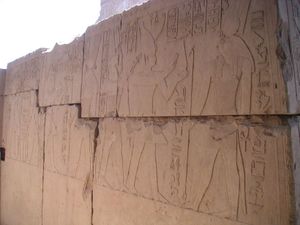سوبكإمساف الأول
| Sobekemsaf I | |||||||||||||||||||||||||||||||||||||||||||||||||||||||||||||||||||||||||||||||||||||||
|---|---|---|---|---|---|---|---|---|---|---|---|---|---|---|---|---|---|---|---|---|---|---|---|---|---|---|---|---|---|---|---|---|---|---|---|---|---|---|---|---|---|---|---|---|---|---|---|---|---|---|---|---|---|---|---|---|---|---|---|---|---|---|---|---|---|---|---|---|---|---|---|---|---|---|---|---|---|---|---|---|---|---|---|---|---|---|---|
 Relief of Sekhemre Wadjkhaw Sobekemsaf at the Temple of karnak. | |||||||||||||||||||||||||||||||||||||||||||||||||||||||||||||||||||||||||||||||||||||||
| فرعون مصر | |||||||||||||||||||||||||||||||||||||||||||||||||||||||||||||||||||||||||||||||||||||||
| سبقه | Rahotep | ||||||||||||||||||||||||||||||||||||||||||||||||||||||||||||||||||||||||||||||||||||||
| تبعه | Sobekemsaf II | ||||||||||||||||||||||||||||||||||||||||||||||||||||||||||||||||||||||||||||||||||||||
| |||||||||||||||||||||||||||||||||||||||||||||||||||||||||||||||||||||||||||||||||||||||
| القرينة | Nubemhat | ||||||||||||||||||||||||||||||||||||||||||||||||||||||||||||||||||||||||||||||||||||||
| الأنجال | prince Sobekemsaf D (future Sobekemsaf II), Sobekemheb | ||||||||||||||||||||||||||||||||||||||||||||||||||||||||||||||||||||||||||||||||||||||
سوبكإمساف الأول Sobekemsaf I (أو الاسم الكامل سخمرع شدتاوي سوبكإمساف) كان فرعوناً مصرياً من الأسرة المصرية السابعة عشر حكم أثناء الفترة الانتقالية الثانية، عندما كانت مصر يحكمها ملوك عدة (وكان يـُعتقد أنه ينتمي إلى الأسرة 13). اسم العرش له، سخمرع شدتاوي، يعني "قوي هو رع؛ منقذ الأرضين."[1] ويعتقد علماء المصريات الآن أن سوبكإمساف الأول كان والد كل من أنتف السادس و أنتف السابع بناء على نقش على عضادة باب اكتـُشفت في معبد للأسرة 17 في جبل أنتف في مطلع عقد 1990 والذي بناه نبخپررع أنتف السابع. تذكر عضادة الباب ملكاً اسمه سوبكإم[ساف] كوالد نبخپررع أنتف السابع--(أنتف ابن سوبكإم...) [2]
سرقة مقبرة سوبك إم ساف
بردية أبوت وليوپولد-أمهرست، التي تعود إلى السنة 16 من عهد رمسيس التاسع، تذكر أن المقبرة الهرمية الملكية لهذا الفرعون قد اُنتـُهكت ودمرها لصوص المقابر. تفاصيل الاعترافات ومحاكمات سرقة المقبرة للرجال المسئولين عن نهب مقبرة سخمرع شدتاوي سوبكإمساف مذكورة في البردية المؤرخة في السنة 16، III پرت، اليوم 22 من عهد رمسيس التاسع. ويقول المستند أن شخصاً اسمه Amenpnufer, son of Anhernakhte, a stonemason from the Temple of Amun Re "fell into the habit of robbing the tombs [of noblemen in West Thebes] in company with the stonemason Hapiwer" and mentions that they robbed Sobekemsaf's tomb along with six other accomplices in Year 13 of Ramesses IX.[3] Amenpnufer confesses that they
...went to rob the tombs...and we found the pyramid of [king] Sekhemre Shedtaui, the son of Re Sebekemsaf, this being not at all like the pyramids and tombs of the nobles which we habitually went to rob.[4]
In his trial, Amenpnufer testifies that he and his companions dug a tunnel into the king's pyramid with their copper tools:
Then we broke through the rubble...and we found this god (king) lying at the back of his burial-place. And we found that the burial-place of Nubkhaas, his queen, situated beside him...We opened their sarcophagi and their coffins in which they were, and found the noble mummy of this King equipped with a falcon; a large number of amulets and jewels of gold were upon his neck, and his head-piece of gold was upon him. The noble mummy of this King was completely bedecked with gold, and his coffins were adorned with gold and silver inside and out and inlaid with all kinds of precious stones. We collected the gold on the noble mummy of this god...and we collected all that we found on her (the Queen) likewise; and we set fire to their coffins. We took their furniture...consisting of articles of gold, silver and bronze, and divided them amongst ourselves...Then we crossed over to Thebes. And after some days the District Superintendent of Thebes heard that we had been stealing in the west, and they seized me and imprisoned me in the office of the Mayor of Thebes. And I took the twenty deben of gold which had fallen to me as my portion and gave them to Khaemope, the scribe of the quarter attched to the landing place of Thebes. He released me, and I rejoined my companions, and they compensated me with a portion once again, Thus I, together, with other thieves who are with me, have continued to this day in the practise of robbing the tombs of the nobles and the [deceased] people of the land who rest in the west of Thebes.[5]
Amenphufer states that the treasures taken from the two royal mummies amounted to "160 deben of gold" or 32 lbs (14.5 kg).[6] The document ends with the conviction of the thieves--with a probable death sentence--and notes that a copy of the official trial transcripts was dispatched to Ramesses IX in Lower Egypt. Amenpnufer himself would have been sentenced to death by impalement, a punishment which "was reserved for [only] the most heinous crimes" in Ancient Egypt.[7]
المصادر
- ^ Peter Clayton, Chronicle of the Pharaohs, Thames and Hudson Ltd, paperback 2006. p.94
- ^ mentioned by Kim Ryholt: The Political Situation in Egypt 266-270 394 File 17/4.6 & p.270
- ^ Leonard Cottrell, The Lost Pharaohs, Pan Books, 8th printing:1977, p.135
- ^ Cotttrell, Ibid., p.135
- ^ Cottrell, Ibid., pp.135-36
- ^ Peter Clayton, Chronicle of the Pharaohs, Thames & Hudson Ltd, 1994, p.171
- ^ Anton Gill, Ancient Egyptians: The Kingdom of the Pharaohs brought to Life," Harper Collins Entertainment, 2003. p.176-77
كتب
- Kim Ryholt: The Political Situation in Egypt during the Second Intermediate Period c.1800-1550 B.C, Museum Tuscalanum Press. ISBN 87-7289-421-0, 393 File 17/2
- Leonard Cottrell, The Lost Pharaohs, Pan Books London and Sydney, 8th printing:1977
| سبقه رع حوتپ |
فرعون مصر الأسرة السابعة عشر |
تبعه أنتف السادس |
